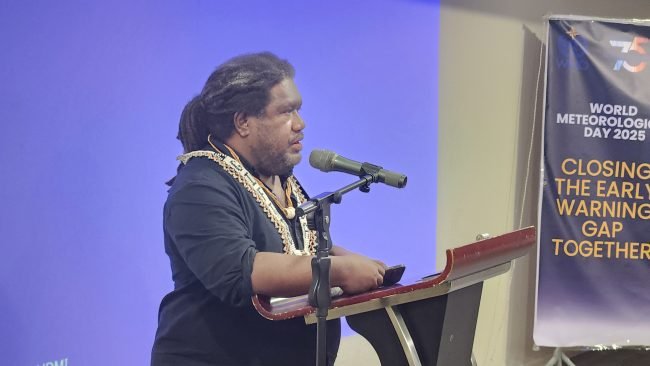
Strengthening early warning systems, a key to protect Solomon Islands’ communities from weather and climate related hazards
By Alfred Pagepitu
Strengthening the early warning system is key to protect vulnerable communities from extreme weather events and climate related hazards.
In Solomon Islands, strengthening the early warning system has been an ongoing priority for the Solomon Islands Meteorological (MET) Services.
At this year’s World Meteorological Day celebration held in Honiara on Wednesday, the outgoing Director of Meteorology, David Hiriasia highlighted the importance of strengthening early warning systems.
This is in line with the theme “Closing the Early Warning Gap Together” that calls for addressing gaps affecting the early warning system.”
“Early warnings are any system put in place to analyze and identify potential weather and climate-related risks and hazards.
“There are two main things to consider: weather and climate.”

Outgoing Director of the Solomon Islands Meteorology, David Hiriasia
Hiriasia explained in terms of rapid onset, there are hazards like tropical cyclones while in slow onset, there are hazards like drought.
“So, in early warning, the goal is to pass on information that can be used by people or organizations to make decisions.
“It’s all about anticipating reactions and preparing for responses. Accidents must be anticipated in order to respond effectively.
“This is why early warnings are crucial. They help people and organizations prepare and respond effectively to potential hazards.
“Anticipate the need, where a little bit of selection is in sight for help for your recovery. But always come together to follow. First, you deal with accidents, and then focus on recovery,” Hiriasia explained.
In Solomon Islands, where communities are isolated and highly vulnerable to extreme weather conditions including climate change closing the early warning system gap means considering diverse hazards.
This effort requires an effective system that is Multi-Hazard, End-to-End, and People-Centered, with strengths in disaster risk knowledge, detection, observation, monitoring, analysis, and forecasting, warning dissemination and communication and preparedness and response capabilities.
Meanwhile the Solomon Islands Government through the Ministry of Environment, Climate Change, Meteorology, and Disaster Management is making every effort to strengthen Multi-Hazard Early Warning Systems at the national, provincial, and community levels.
[end]
